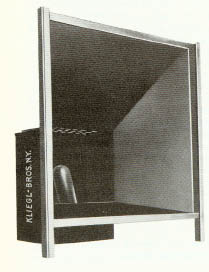Linnebach projector (Q639)
From CanonBase
lensless and reflector-less projector by which silhouettes, colour, and broad outlines can be projected as part of the background scenery.
| Language | Label | Description | Also known as |
|---|---|---|---|
| English | Linnebach projector | lensless and reflector-less projector by which silhouettes, colour, and broad outlines can be projected as part of the background scenery. |
Statements
31
0 references
Linnebach lantern, also called Linnebach projector, theatrical lighting device by which silhouettes, colour, and broad outlines can be projected as part of the background scenery. Originally developed in the 19th century by the German lighting expert Adolf Linnebach, it is a concentrated-filament, high-intensity lamp placed in a deep box painted black inside. One side of the box is open and contains a glass or mica slide carrying the design to be projected; it can be projected from behind onto a translucent screen or from the front of the stage onto a backdrop. The device has been refined to include a wide-angle-lens system that prevents the radical distortion of the image. Advances in projection equipment replaced the Linnebach lantern after the mid-20th century. https://www.britannica.com/art/Linnebach-lantern (English)
0 references
1917
0 references
Linnebach projector
1917 (English)
The Linnebach projector is a lenseless projection system, mainly used to create background images on stage. It was developed by Adolf Linnebach around 1917 and used by a few theatres in the 1920s. The projector comprises a powerful point-source lamp such as an arc light, and a large transparent slide with the image on it.
1906
0 references
